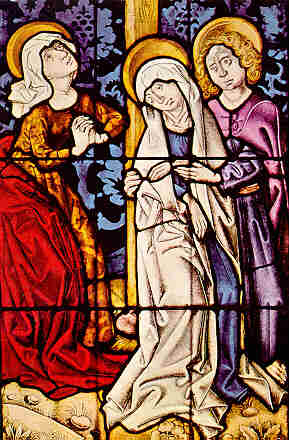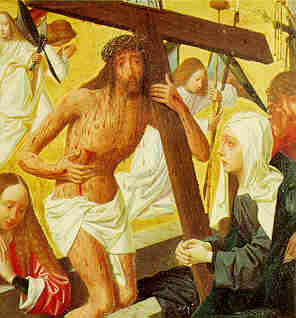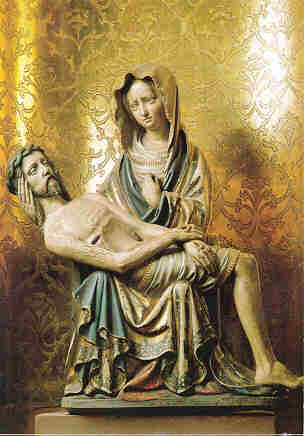Mother of Sorrows
Mother of Sorrows
Mary, Mother of Sorrows: The Mystery of Comfort and Hope
– Louis J. Cameli
Iuxta crucem tecum stare
ac me tibi sociare
in planctu desidero.
Fac ut portem Christi mortem
passionis fac me sortem
et plagas recolere.
I want to stand with
you next to the cross
and I want to join you in your grieving.
Make me bear Christ's death
make me share his passion
make me recall his wounds.

Ten or twenty years ago, it would have been unthinkable or, at least, improbable, to consider writing about Mary as the mother of sorrows. Devotion to Mary under that title and in Roman Catholic circles had its heyday in the 40s and 50s. Time has passed and given us larger perspectives. The flood of peppy and overly optimistic postconciliar spiritualities failed to satisfy people, precisely because they did not and could not engage people on the level of suffering.
There is a vast quantity of suffering in the world. It extends from deeply personal and hidden domains through social patterns and global realities. It even reaches a cosmic dimension. These abstract levels of suffering are marked out very specifically by sorrowing mothers. In some particular and powerful way, a large quantity of human suffering coalesces in the hearts of mothers. In this context, the early and, in the Christian tradition, paradigmatic figure of Mary, mother of sorrows, is worth pursuing for greater understanding.
Even before a theology of suffering was elaborated, the images of a young and suffering mother bearing a child in a hostile world and an older mother standing before the cross of her son as he was dying captivated generations of believers. The embodiment in art and poetry and music of the Mater Dolorosa suggests that priority needs to be given to the primary experience which is both imaginative and affective.
An example of giving priority to the imaginative is found in the remarkable medieval hymn Stabat Mater (verses above). When these and other similar verses are read in a perspective of male-female dynamics and spirituality, some significant conclusions emerge. The poet, a man, is asking a woman, Mary, to help him to identify with, join with, and participate in, the sufferings and death of another man, Jesus.
Read in this way, the Stabat Mater highlights the need or, perhaps more accurately, the necessity of Mary in the spiritual journey. Gerald May says, "... in my experience I have never met a sincere Western spiritual seeker who did not have to encounter Mary at some point along the way, regardless of that seeker's religious denomination. The image of Mary allows both men and women to relate their images of the divine in ways simply not possible with a totally male divinity."
The Stabat Mater, I suggest, captures a way in which Mary gives access to all believers to the mystery of Jesus Christ. In a particular way, she provides male believers with a possibility for intimate relationship with the suffering and dying Jesus, that is, on the level of his vulnerabilities and our vulnerabilities as well as on the level of strong affect or feeling.

Although admiration and veneration are both historically and theologically valid and appropriate, another dimension of Marian devotion, recently recovered and reemphasized by Paul VI in Marialis Cultus, needs our attention. The other dimension is identification with Mary or the imitation of Mary. Identification with Mary means that Christians see her and say not only "Look, there is the mother of sorrows," and admire her; they also say, "Here is a life and faith pattern which I can call my own."
If we are to trace the biblical witness to Mary's sufferings, her experience of sorrow, a fundamental distinction is necessary. We are following the experience of someone whose title is sorrowful mother, not depressed mother. In the gospels as documents of faith, we have Mary's experience of suffering presented in a context of faith, hope, and love. Were the gospels to chronicle her pain simply in a context of sadness, perhaps anger, a lack of resolution, and ultimately without perceived hope, then she would not emerge as a pained, sorrowing, yet faith-filled person but rather as a depressed person.
The sufferings endured by Mary were complex. As we noted, the gospel narratives often mix a joy and a sorrow. Their layered descriptions ring true to the texture of real life. In a similar way, one would expect and correctly find a complexity in the responses of Mary to suffering. Although we instinctively look for a single solution to "the problem of suffering," faith and, more specifically, the Mary experience in the New Testament lead us to a multifaceted approach. I will describe her responses under the categories of struggle, presence, expansion, and surrender.
(Gerald G. May, Will and Spirit: A Contemplative Psychology, 147-8).
1) STRUGGLE – Mary's first response to suffering is struggle. Because of an excessively passive piety in the past, we may be surprised that struggle can be named the first response to suffering. Mary's "yes" is not mere acquiescence but active engagement in the unfolding of salvation. Mary's response to suffering by way of struggle becomes clear in the Magnificat. Here we find suffering, struggle, hope, courage and anticipation.
2) PRESENCE – As she shares in the sufferings of her son, Mary accompanies him, does not "do" anything. Hers is an active and engaged presence which includes knowing, understanding, accepting and loving. When "nothing can be done" medically, socially, psycho-therapeutically, or whatever way, then the core needs of people emerge. They are being known, being understood, being accepted, being loved. These elements form the content of Mary's presence.
3) EXPANSION – A significant response of Mary to suffering is an expansion of consciousness and of concern. The gospel narratives are quite clear about this. At the cross, in John's Gospel, she faces the greatest loss. Precisely at that moment, she expands her embrace and receives the beloved disciple and, symbolically, all other disciples as their mother. In the face of her most intense suffering, she expands the arena of her concern.
4) SURRENDER – Mary's surrender is a surrender to God. Psychologically, that means not clinging to her control over matters or outcomes. In faith, it means the radical acknowledgment of God's sovereignty. In hope, it means re-imagining the future, not simply making the future an extrapolation of the present. In love, it means the movement toward the union of wills with the one who loves us absolutely, unconditionally.

The mystery of suffering is a mystery of connection and disconnection. The overall pattern of Mary emergent in our reflection is to link us with Jesus in his suffering and dying and rising, to link us with one another as we share common struggles and suffering, to link us with a larger world of concern. Mary comforts primarily by being a sacrament of God's compassion, enduring, promising, supporting.
How can Mary be the sorrowful mother if she has been gloriously assumed into heaven? Recall the image of the appearing risen Lord who continues to bear the wounds of his passion. He is glorified and wounded still. For the mystery is one: death and resurrection. Similarly, Mary is both virgo assumpta and mater dolorosa . Her sufferings and sorrows have shaped her glory. She is "a sign of sure hope and solace for the pilgrim people of God."
Source: Louis J. Cameli, abridged from the article with same title which appeared in Chicago Studies, 27, 1: April, 1988, 3;15. This excerpt appeared in The Marian Library Newsletter, Spring, 1991.
Images shown:
Crucifixion (fragment), Church at Walburg, Lower Rhine
Man of Sorrows, Geertgen tot Sint Jans
Pieta, detail of the Marian altar in the Lady Chapel, Frankfurt, Germany
All About Mary includes a variety of content, much of which reflects the expertise, interpretations and opinions of the individual authors and not necessarily of the Marian Library or the University of Dayton. Please share feedback or suggestions with marianlibrary@udayton.edu.
